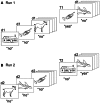Orbitofrontal reality filtering
- PMID: 23772208
- PMCID: PMC3677127
- DOI: 10.3389/fnbeh.2013.00067
Orbitofrontal reality filtering
Abstract
Decades of research have deepened our understanding of how the brain forms memories and uses them to build our mental past and future. But how does it determine whether an evoked memory refers to the present and can be acted upon? The study of patients who confuse reality, as evident from confabulation and disorientation, has opened ways to explore this vital capacity. Results indicate that the brain recurs to a phylogenetically old faculty of the orbitofrontal cortex - extinction - and structures of the reward system to keep thought and behavior in phase with reality.
Keywords: confabulations; continuous recognition; orbitofrontal cortex; reality monitoring; reward system.
Figures



Similar articles
-
Frontal tDCS modulates orbitofrontal reality filtering.Neuroscience. 2014 Apr 18;265:21-7. doi: 10.1016/j.neuroscience.2014.01.052. Epub 2014 Feb 4. Neuroscience. 2014. PMID: 24508152
-
Mechanism of disorientation: reality filtering versus content monitoring.Cortex. 2013 Nov-Dec;49(10):2628-36. doi: 10.1016/j.cortex.2013.07.014. Epub 2013 Aug 11. Cortex. 2013. PMID: 24012137
-
Forms of confabulation: dissociations and associations.Neuropsychologia. 2012 Aug;50(10):2524-34. doi: 10.1016/j.neuropsychologia.2012.06.026. Epub 2012 Jul 7. Neuropsychologia. 2012. PMID: 22781813
-
What does extinction have to do with confabulation?Cortex. 2017 Feb;87:5-15. doi: 10.1016/j.cortex.2016.10.015. Epub 2016 Nov 1. Cortex. 2017. PMID: 27852471 Review.
-
Spontaneous confabulation, reality monitoring, and the limbic system--a review.Brain Res Brain Res Rev. 2001 Oct;36(2-3):150-60. doi: 10.1016/s0165-0173(01)00090-x. Brain Res Brain Res Rev. 2001. PMID: 11690611 Review.
Cited by
-
A synthesis of evidence on inhibitory control and auditory hallucinations based on the Research Domain Criteria (RDoC) framework.Front Hum Neurosci. 2014 Mar 26;8:180. doi: 10.3389/fnhum.2014.00180. eCollection 2014. Front Hum Neurosci. 2014. PMID: 24723879 Free PMC article.
-
Effectiveness of a neuropsychological treatment for confabulations after brain injury: A clinical trial with theoretical implications.PLoS One. 2017 Mar 3;12(3):e0173166. doi: 10.1371/journal.pone.0173166. eCollection 2017. PLoS One. 2017. PMID: 28257420 Free PMC article. Clinical Trial.
-
Confabulations in Alcoholic Korsakoff's Syndrome: A Factor Analysis of the Nijmegen-Venray Confabulation List.Assessment. 2021 Sep;28(6):1545-1555. doi: 10.1177/1073191119899476. Epub 2020 Jan 12. Assessment. 2021. PMID: 31928078 Free PMC article.
-
No Influence of Positive Emotion on Orbitofrontal Reality Filtering: Relevance for Confabulation.Front Behav Neurosci. 2016 May 31;10:98. doi: 10.3389/fnbeh.2016.00098. eCollection 2016. Front Behav Neurosci. 2016. PMID: 27303276 Free PMC article.
-
Cerebellar engagement in the attachment behavioral system.Sci Rep. 2022 Aug 9;12(1):13571. doi: 10.1038/s41598-022-17722-x. Sci Rep. 2022. PMID: 35945247 Free PMC article.
References
-
- Bleuler E. (1923). Lehrbuch der Psychiatrie. Berlin: Julius Springer Verlag
LinkOut - more resources
Full Text Sources
Other Literature Sources
Miscellaneous

